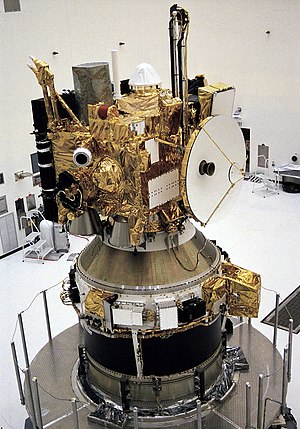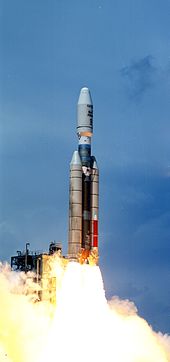Mars Observer
| Mars Observer | |
|---|---|
 |
|
| NSSDC ID | 1992-063A |
| Mission goal | Mars |
| Client | NASA |
| Launcher | Titan III / Commercial |
| construction | |
| Takeoff mass | 1018 kg |
| Course of the mission | |
| Start date | September 25, 1992 |
| launch pad | CCAFS LC-40 |
| End date | Loss of contact on August 21, 1993 |
Mars Observer was a NASA - space probe to Mars , launched 1,992th In 1993 contact was lost four days before the launch into Mars orbit and could never be re-established. The exact cause is still unknown.
procedure

Mars Observer was launched on 25 September 1992 aboard a launch vehicle of the type Titan III / Commercial from Launch Complex 40 at Cape Canaveral into space. After reaching Earth orbit, the satellite was accelerated towards Mars using the Transfer Orbit Stage .
Malfunctions already occurred during the flight, for example the probe lost its orientation several times due to dirty and defective navigation sensors. On July 27, 1993, the MOC camera took the only two images of Mars ever sent to Earth by Mars Observer. When the preparations for launching into Mars orbit finally began on August 21, 1993, three days before arrival, the Mars Observer stopped calling. All attempts to establish contact remained unsuccessful, so that the probe was officially declared lost on September 22, 1993.
Instruments
- MOC (Mars Observer Camera) : A high-resolution CCD line camera.
- MOLA (Mars Orbiter Laser Altimeter) : MOLA was supposed to create a topographical map of Mars from the differences in the runtime of the laser .
- MAG / ER (Magnetometer / Electron Reflectometer) : MAG / ER's task was to look for a weak magnetic field on Mars.
- TES (Thermal Emission Spectrometer) : TES was supposed to study the mineralogical composition of Mars.
- RS (Radio Science) : RS would have radioed with the on-board transmitters through the Martian atmosphere to earth in order to investigate the structure of the atmosphere.
- PMIR (Pressure Modulated Infrared Radiometer) : PMIR should measure the radiation emitted by the Martian surface and thus allow conclusions to be drawn about the climate.
- GRS (Gamma Ray Spectrometer) : GRS would have searched for water using gamma radiation .
Possible causes
The investigative commission published the following possible reasons for the failure:
- A deflagration in the engines caused the orbiter to turn from its normal position. This activated a safety mode that stopped all running processes - and thus also the planned contact with the earth.
- The power supply failed after a transistor failed. The transistor series used also caused problems on board weather satellites.
- The failure of the pressure regulation in the fuel tank damaged the tank and the probe was no longer able to correct its position.
- The fuel lines were damaged by the pyrotechnic engine ignition.
However, all of these causes are speculative as there was no telemetry at all at the time of loss of contact.
consequences
The loss of the expensive Mars Observer came as a shock to American space travel - it was not only one of NASA's most expensive and ambitious projects, with an estimated total cost of $ 813 million, but also the first NASA planetary probe since Mariner 8 in 1971 lost. Six of the seven instruments flew back to the red planet on the Mars Global Surveyor and 2001 Mars Odyssey probes . The seventh instrument, PMIR, was supposed to go to Mars with the Mars Climate Orbiter , but was not used due to the loss of the mission. As a consequence, the Discovery program followed for NASA , in which instead of a few expensive probes, many small, cheap probes were to be started.
See also
Web links
- Bernd Leitenberger: The Mars Observer
- NASA: NASA: Mars Observer (English)
- Mars Observer in the NSSDCA Master Catalog (English)
Individual evidence
- ↑ NASA: MARS OBSERVER PRESS KIT, SEPTEMBER 1992 in the Internet Archive; accessed on February 3, 2016 ( Memento from February 25, 2004 in the Internet Archive )
- ↑ NASA - NSSDCA - Spacecraft - Details. Retrieved July 17, 2020 .


